Tobermory is known as the "Scuba Diving Capital of Canada". The natural attractions of this small community of approximately 4,000 people include the Bruce Peninsula National Park and charming Flowerpot Island. Tobermory is also the gateway to Fathom Five National Marine Park.
Tobermory is located on the northern tip of the Bruce Peninsula in Ontario.
It is part of the municipality of Northern Bruce Peninsula and is located just over 180 miles northwest of Toronto. Tobermory separates Lake Huron from Georgian Bay and is known for its rugged landscape and waterfront.
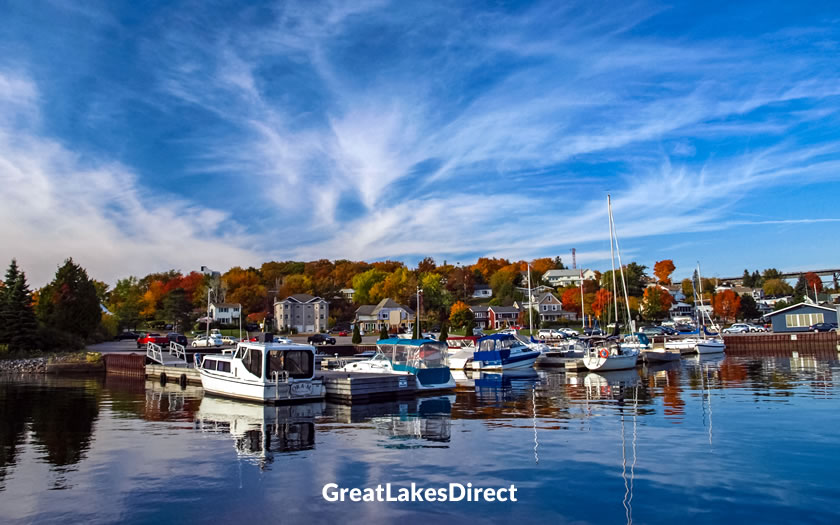
Tobermory harbour at the end of the Bruce Peninsula
The small population varies from season to season, as many businesses in the area rely on tourism and close during the winter months.
The major international airport near Toronto is easily the preferred option for those looking to fly. The airport is the closest and has the largest choice of flights and destinations.
Distance to Toronto Pearson International Airport: 171 miles
Distance to London International Airport: 185 miles
Distance to Hamilton International Airport: 192 miles
Tobermory is situated at the northern end of the southern part of the ON-6 state highway - sometimes referred to as the 'King's Highway'. The highway runs south to Owen Sound and Guelph.
The northern part of Highway 6 restarts on Manitoulin Island in the port of South Baymouth. From there it continues north onto the mainland before joining the TransCanada Highway slightly north of Espanola.
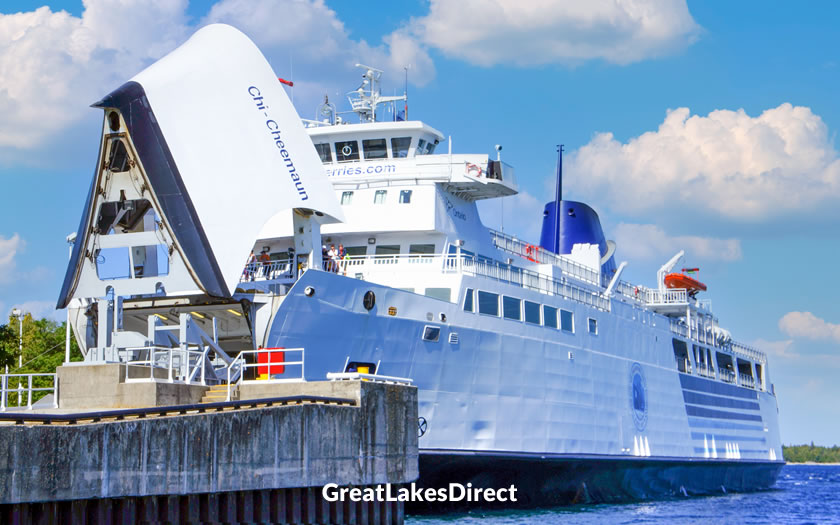
The Chi-Cheemaun ferry in Tobermory harbour
Tobermory is connected to Manitoulin Island by the Chi-Cheemaun ferry service. This passenger and vehicle ferry operates from the end of the first week in May through to mid-October.
Tobermory was originally a small fishing settlement known as 'Bury' - the name is presumed to have changed because of the influence of locals with a Scottish heritage. (Tobermory is also the name of a settlement on the Isle of Mull in Scotland.)
Although plots of land were sold to settlers for agricultural use, the land was unsuited to raising crops or supporting animals and most locals working in the fishing or lumber industries.
Things changed with the establishment of the road connection to the northern Bruce Peninsula and tourism started to boom.
The Bruce Peninsula National Park was established in 1987 to protect the landscape of the Niagara Escarpment, while the Fathom Five National Marine Park was set up at the same time and aims to conserve the freshwater environment in the Georgian Bay region.
The Parks Canada visitor centre for the Bruce Peninsula National Park and the Fathom Five Marine Park is located five minutes' walk along the Bruce Trail from Tobermory harbour.
The visitor centre houses exhibits and a lookout tower for views over the town and surrounding area. It is open every day apart from important public holidays such as Christmas Day and New Year's Day.
Tobermory is home to two distinct harbours: Big Tub Harbour and Little Tub Harbour.
Big Tub Harbour is known for being Canada's largest natural freshwater harbour. It is a deep, sheltered bay popular with scuba divers due to its clear waters and shipwrecks, such as the Sweepstakes and the City of Grand Rapids. These lie close to the surface and are fascinating for underwater exploration.
Big Tub Harbour is also recognized for its picturesque lighthouse, which guides vessels through the sometimes treacherous waters of the peninsula.
Little Tub Harbour, on the other hand, is the main harbour of Tobermory and serves as the economic and recreational centre of the village. It is smaller than Big Tub but is bustling with activity, featuring marinas, boat tours, shops, restaurants, and accommodation.
Little Tub Harbour is the departure point for the Chi-Cheemaun ferry to Manitoulin Island and for various cruises to Flowerpot Island and Fathom Five National Marine Park.
Flowerpot Island is accessible only by boat. Several companies operate boat tours that not only take you to the island but also offer glass-bottom boat views of shipwrecks in the Fathom Five National Marine Park. The trip usually takes about 30 minutes one way.
Most visitors spend half a day to a full day on the island, depending on how much hiking and exploring they plan to do.
On Flowerpot Island you can explore its famous rock formations, "flowerpots", large sea stacks formed by erosion over millennia. Don't miss the historic Flowerpot Light Station and the cave system near the beach.
It's best to bring your own snacks and water as there are no food facilities on the island. The terrain can be rocky and uneven, so sturdy shoes are recommended.
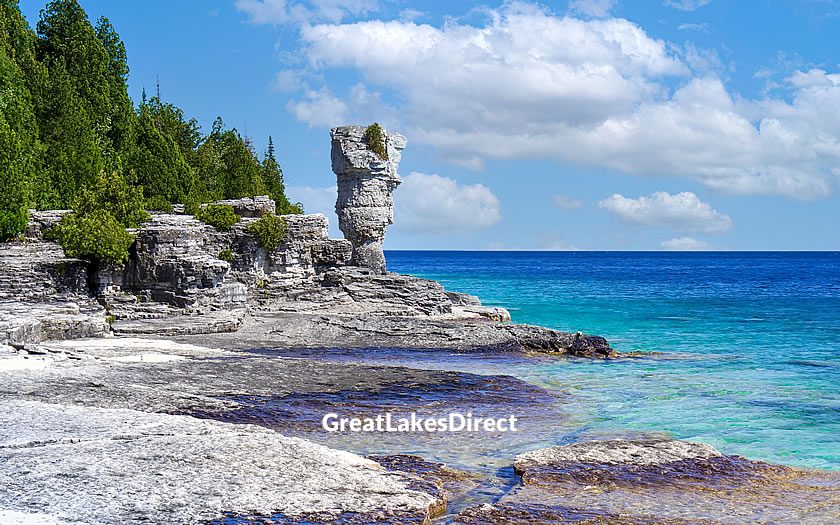
Flowerpot Island just off the coast from Tobermory
Bruce Peninsula National Park was established in 1987 to protect the unique ecological and geological features of the region, which is part of the UNESCO-designated Niagara Escarpment World Biosphere Reserve.
Some of the park's most popular attractions include the Grotto, a natural sea cave with a pool of blue water, and Indian Head Cove, a picturesque spot ideal for swimming and picnicking.
The park is also home to the Singing Sands beach, with fine sand that "sings" when visitors walk on it. Cyprus Lake Campground provides a base for activities such as hiking, as the park includes part of the famous Bruce Trail, Canada's oldest and longest marked trail.
A look at Tobermory in Ontario
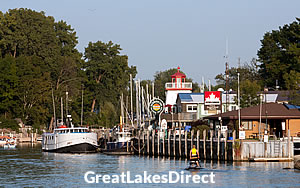
Founded in the mid-19th century, Grand Bend has grown into a popular tourist destination, attracting visitors from across Ontario and beyond. The town's main beach, Grand Bend Beach, stretches for nearly two miles and offers a variety of activities including swimming, sunbathing, volleyball and kiteboarding.
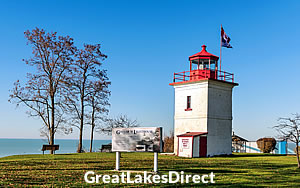
Goderich is a charming town in the heart of Huron County, Ontario. It is known for its picturesque architecture and stunning natural beauty. Founded in 1827, Goderich has a well-preserved downtown area with historic buildings such as the Huron Historic Gaol and the Huron County Museum.
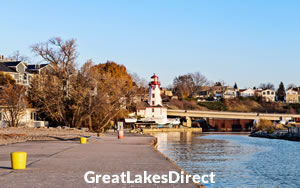
Kincardine is a small town located on the shores of Lake Huron in Bruce County, Ontario. It is known for its beautiful beaches, picturesque lighthouse and Scottish heritage. Founded in 1848, Kincardine has maintained its small-town charm while offering visitors a variety of attractions and activities.
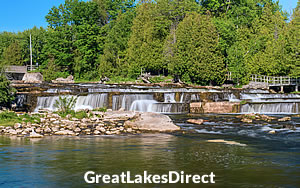
Sauble Beach is known for its sandy beaches, crystal clear waters and lively summertime atmosphere. Established in the late 1800s, Sauble Beach has grown into one of the largest freshwater beach destinations in the world, stretching over seven miles.
Tobermory Chamber of Commerce : tobermory.com
Bruce Peninsula National Park : parks.canada.ca
Fathom Five
Marine Park : parks.canada.ca
Blue Heron Cruises : www.cruisetobermory.com
Bruce Anchor Cruises : cruises.bruceanchor.com